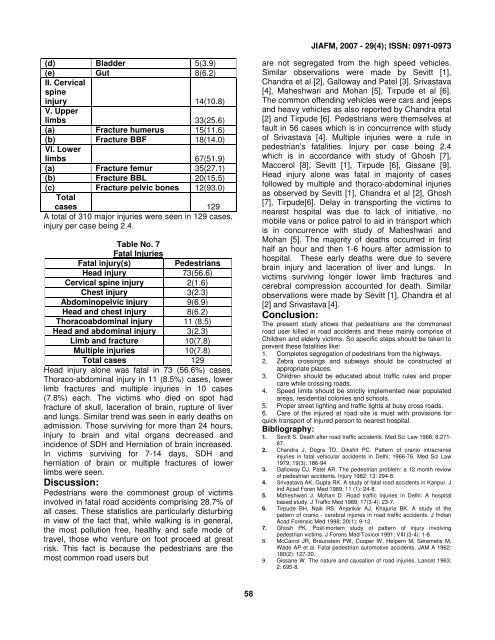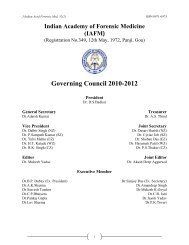Download - forensic medicine
Download - forensic medicine
Download - forensic medicine
You also want an ePaper? Increase the reach of your titles
YUMPU automatically turns print PDFs into web optimized ePapers that Google loves.
JIAFM, 2007 - 29(4); ISSN: 0971-0973<br />
(d) Bladder 5(3.9)<br />
(e) Gut 8(6.2)<br />
II. Cervical<br />
spine<br />
injury 14(10.8)<br />
V. Upper<br />
limbs 33(25.6)<br />
(a) Fracture humerus 15(11.6)<br />
(b) Fracture BBF 18(14.0)<br />
VI. Lower<br />
limbs 67(51.9)<br />
(a) Fracture femur 35(27.1)<br />
(b) Fracture BBL 20(15.5)<br />
(c) Fracture pelvic bones 12(93.0)<br />
Total<br />
cases 129<br />
A total of 310 major injuries were seen in 129 cases,<br />
injury per case being 2.4.<br />
Table No. 7<br />
Fatal Injuries<br />
Fatal injury(s) Pedestrians<br />
Head injury 73(56.6)<br />
Cervical spine injury 2(1.6)<br />
Chest injury 3(2.3)<br />
Abdominopelvic injury 9(6.9)<br />
Head and chest injury 8(6.2)<br />
Thoracoabdominal injury 11 (8.5)<br />
Head and abdominal injury 3(2.3)<br />
Limb and fracture 10(7.8)<br />
Multiple injuries 10(7.8)<br />
Total cases 129<br />
Head injury alone was fatal in 73 (56.6%) cases,<br />
Thoraco-abdominal injury in 11 (8.5%) cases, lower<br />
limb fractures and multiple injuries in 10 cases<br />
(7.8%) each. The victims who died on spot had<br />
fracture of skull, laceration of brain, rupture of liver<br />
and lungs. Similar trend was seen in early deaths on<br />
admission. Those surviving for more than 24 hours,<br />
injury to brain and vital organs decreased and<br />
incidence of SDH and Herniation of brain increased.<br />
In victims surviving for 7-14 days, SDH and<br />
herniation of brain or multiple fractures of lower<br />
limbs were seen.<br />
Discussion:<br />
Pedestrians were the commonest group of victims<br />
involved in fatal road accidents comprising 28.7% of<br />
all cases. These statistics are particularly disturbing<br />
in view of the fact that, while walking is in general,<br />
the most pollution free, healthy and safe mode of<br />
travel, those who venture on foot proceed at great<br />
risk. This fact is because the pedestrians are the<br />
most common road users but<br />
are not segregated from the high speed vehicles.<br />
Similar observations were made by Sevitt [1],<br />
Chandra et al [2], Galloway and Patel [3], Srivastava<br />
[4], Maheshwari and Mohan [5], Tirpude et al [6].<br />
The common offending vehicles were cars and jeeps<br />
and heavy vehicles as also reported by Chandra etal<br />
[2] and Tirpude [6]. Pedestrians were themselves at<br />
fault in 56 cases which is in concurrence with study<br />
of Srivastava [4]. Multiple injuries were a rule in<br />
pedestrian’s fatalities. Injury per case being 2.4<br />
which is in accordance with study of Ghosh [7],<br />
Maccerol [8], Sevitt [1], Tirpude [6], Gissane [9].<br />
Head injury alone was fatal in majority of cases<br />
followed by multiple and thoraco-abdominal injuries<br />
as observed by Sevitt [1], Chandra et al [2], Ghosh<br />
[7], Tirpude[6]. Delay in transporting the victims to<br />
nearest hospital was due to lack of initiative, no<br />
mobile vans or police patrol to aid in transport which<br />
is in concurrence with study of Maheshwari and<br />
Mohan [5]. The majority of deaths occurred in first<br />
half an hour and then 1-6 hours after admission to<br />
hospital. These early deaths were due to severe<br />
brain injury and laceration of liver and lungs. In<br />
victims surviving longer lower limb fractures and<br />
cerebral compression accounted for death. Similar<br />
observations were made by Sevitt [1], Chandra et al<br />
[2] and Srivastava [4].<br />
Conclusion:<br />
The present study shows that pedestrians are the commonest<br />
road user killed in road accidents and these mainly comprise of<br />
Children and elderly victims. So specific steps should be taken to<br />
prevent these fatalities like:<br />
1. Completes segregation of pedestrians from the highways.<br />
2. Zebra crossings and subways should be constructed at<br />
appropriate places.<br />
3. Children should be educated about traffic rules and proper<br />
care while crossing roads.<br />
4. Speed limits should be strictly implemented near populated<br />
areas, residential colonies and schools.<br />
5. Proper street lighting and traffic lights at busy cross roads.<br />
6. Care of the injured at road site is must with provisions for<br />
quick transport of injured person to nearest hospital.<br />
Bibliography:<br />
1. Sevitt S. Death after road traffic accidents. Med Sci Law 1968; 8:271-<br />
87.<br />
2. Chandra J, Dogra TD, Dikshit PC. Pattern of cranio intracranial<br />
injuries in fatal vehicular accidents in Delhi; 1966-76. Med Sci Law<br />
1979; 19(3): 186-94<br />
3. Galloway DJ, Patel AR. The pedestrian problem: a 12 month review<br />
of pedestrian accidents. Injury 1982; 13: 294-8.<br />
4. Srivastava AK, Gupta RK. A study of fatal road accidents in Kanpur. J<br />
Ind Acad Foren Med 1989; 11 (1): 24-8.<br />
5. Maheshwari J, Mohan D. Road traffic injuries in Delhi: A hospital<br />
based study. J Traffic Med 1989; 17(3-4): 23-7.<br />
6. Tirpude BH, Naik RS, Anjankar AJ, Khajuria BK. A study of the<br />
pattern of cranio - cerebral injuries in road traffic accidents. J Indian<br />
Acad Forensic Med 1998; 20(1): 9-12.<br />
7. Ghosh PK. Post-mortem study of pattern of injury involving<br />
pedestrian victims. J Forens Med Toxicol 1991; VIII (3-4): 1-8.<br />
8. McCarrol JR, Braunstein PW, Cooper W, Helpern M, Seremetis M,<br />
Wade AP et al. Fatal pedestrian automotive accidents. JAM A 1962;<br />
180(2): 127-30.<br />
9. Gissane W. The nature and causation of road injuries. Lancet 1963;<br />
2: 695-8.<br />
58




![syllabus in forensic medicine for m.b.b.s. students in india [pdf]](https://img.yumpu.com/48405011/1/190x245/syllabus-in-forensic-medicine-for-mbbs-students-in-india-pdf.jpg?quality=85)



![SPOTTING IN FORENSIC MEDICINE [pdf]](https://img.yumpu.com/45856557/1/190x245/spotting-in-forensic-medicine-pdf.jpg?quality=85)

![JAFM-33-2, April-June, 2011 [PDF] - forensic medicine](https://img.yumpu.com/43461356/1/190x245/jafm-33-2-april-june-2011-pdf-forensic-medicine.jpg?quality=85)



![JIAFM-33-4, October-December, 2011 [PDF] - forensic medicine](https://img.yumpu.com/31013278/1/190x245/jiafm-33-4-october-december-2011-pdf-forensic-medicine.jpg?quality=85)

